C.H. Cobb's Blog
January 22, 2025
Review of Andrew Snelling’s two-volume Earth’s Catastrophic Past
 It would not be hyperbole to say that these 1100 pages are Snelling’s magnum opus. Extensively documented, irenic in tone, accessing the works and research of both conventional scientists as well as creation scientists, Snelling makes a solid case that the Genesis record of both Creation and Flood is well supported by painstaking science and empirical data.
It would not be hyperbole to say that these 1100 pages are Snelling’s magnum opus. Extensively documented, irenic in tone, accessing the works and research of both conventional scientists as well as creation scientists, Snelling makes a solid case that the Genesis record of both Creation and Flood is well supported by painstaking science and empirical data.In the Introduction, Snelling spells out why it is important to take Genesis seriously. In Section 1, he reviews the biblical record pertaining to Creation and the Flood from both the Old Testament as well as the New. This review enables the reader to understand exactly what Snelling is arguing for, as well as what he is NOT arguing for.
Section 2 considers the opposing arguments that arise outside of geology from other academic disciplines. Noah’s ark and the events surrounding it comprise Section 3. Snelling offers ideas on how the gathering, care, and Post-Flood distribution of species might have been accomplished. A suggested framework for a biblically committed geology occupies Section 4. Volume 1 concludes with Section 5, a look at the modern, conventional geologic synthesis. The Geologic Column and the rock types included in it are discussed extensively, as well as an examination of Plate Tectonics.
Section 6 leads off Volume 2 by an honest examination of the geological implications of both the Creation and Flood models. Such catastrophic events could not help but leave their finger prints on the geologic record, and Snelling shows that those finger prints do in fact exist in the geologic record. Section 7 proposes a biblical geologic model of earth history.
Section 8 considers specific problems in radioactive dating methods. Section 9 exposes contradictions in conventional geology’s treatment of comets, fluctuations in the earth’s magnetic field, sea salts and sediments, volcanic activity and the presence of helium, radiohalos, and population statistics.
Finally, Snelling concludes his magisterial work by examining geologic formations that, on the surface, seem to imply slow deposition over long time periods (i.e. conventional geological interpretations). Using actual observations and experiments Snelling shows that the supposed problems for a biblical understanding of Creation and the Flood are not as intractable as they might first appear.
Earth’s Catastrophic Past is a work of science, not primarily an exposition of Scripture, although it honors and argues for the literal biblical perspective on Creation and the Flood. Snelling documents all his assertions, statistics, facts, and experimental outcomes, whether quoting a conventional geologist or the work done by geologists committed to a biblical paradigm. The two volumes are somewhat accessible for the layman. I say somewhat, because back in the 70’s I got halfway through a degree program in geology at Colorado State before switching schools and majors, but reading Snelling’s work was stretching for me from a scientific standpoint.
In conclusion, Snelling has made a case that requires an answer. He has challenged conventional geological interpretations of earth’s history, exposing theories and conclusions that are not only not supported by the data, but blatantly contradicted by both observation and experiment. Snelling has shown that empirical observations from multiple disciplines not only make room for a biblical view of Creation and the Flood, but beyond that, are best explained by the biblical view.
Five stars, highly recommended.
June 10, 2024
Decommissioning the Doorway Press store
The Doorway Press website was a means by which folks could buy the books directly from me if they wished (I get a much better financial return when you buy my books from me). For the last year there’s been no traffic on that site, so I am cutting my web hosting expenses and shutting it down, though I will keep the Doorwaypress.com domain name.

The name ‟Doorway Press” (as well as the doorway logo) is significant. I intend my novels to be a ‟doorway” inviting the reader to re-examine some of the modern myths of secular thinking even while being engrossed in an action-packed story. The best representatives of that agenda are The Candidate and the Outlander Chronicles series, particularly Outlander Chronicles: Phoenix. While all my books are written from a thoroughly Christian worldview, the Falcon series (book 1 is Falcon Down) does not display quite as strong of a philosophical apologetic as the others.
As far as ‟works in progress,” at present I am not working on any full-length novels. I’ve been tinkering on and off with several different short stories, but that’s pretty much stalled out for the time being.
You can still get books directly from me by contacting me by text, email, or Facebook. All my books are available at Bread of Life Christian Bookstore in Greenville, and of course, on Amazon. Most of my books are also available in the Greenville Public Library, however, I think some of them might have walked off.
While the Doorway Press store has been shut down, the mission continues:
The Mission of Doorway PressDOORWAY PRESS IS THE PUBLISHING IMPRINT OF INDEPENDENT AUTHOR C. H. COBB.FICTION
It is the mission of Doorway Press to publish well-written, exciting tales that captivate the reader on the strength of the story and characters alone. If you find a Doorway Press book hard to put down, we’ve done our job.
Along the way, we also want to provoke questions in the reader’s mind about life, death, meaning, purpose, faith, and postmodern myths of Western society, without bogging the story down in philosophical baggage. If you find yourself taking a second look at your most cherished beliefs after reading a Doorway Press story, we’ve done our job.
NON-FICTIONIt is the mission of Doorway Press to publish well-written, interesting books and studies that properly represent the truths of the Bible as they have been understood since the Reformation. If you have gained a greater love and understanding of Jesus Christ, and a greater passion for the glory of God after reading a Doorway Press non-fiction, we’ve done our job.
December 20, 2023
Review of Surprised by Doubt: How Disillusionment can Invite us to Deeper Faith, by Chatraw and Carson
Surprised by Doubt: How Disillusionment can Invite us to Deeper Faith
This is a reallygood book. It has several problems, which I’ll discuss last, but ifyou just skim book reviews, I want to make my point early on: this isindeed a good book and can be used effectively with those wrestlingwith doubt.
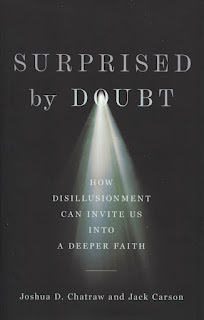
As you mightguess, the title is a take-off on C. S. Lewis’s Surprised byJoy. The similarities rise to more than just the title. Theauthors quote Lewis frequently as they make their case for genuineChristianity. Their writing style is warm and not overlyacademic—also like Lewis’s. On balance the book is an invitationto carefully rethink the issues that have provoked many modernstoward skepticism, or even outright rejection, of the claims of theChristian faith.
One thing thatadds to their credibility is that the authors themselves havestruggled with doubts about their own faith. Another is that theyhonor questions and doubt without dismissing or belittling theskeptic. Instead, they engage with the doubts. Another is theirhumility: they freely admit they don’t have answers for all of thequestions. Carson and Chatraw make a case for mystery—thatunanswerable mystery should be expected when investigating asovereign God.
I’m thankfulthat they are going after base hits, not home runs—they admitrepeatedly that they cannot prove the existence of God or the claimsof the faith. Instead they are building a “wager” that theChristian explanation of reality is far more likely than alternativeexplanations.
The principalmetaphor they employ for the Christian faith is that of a great housewith many rooms, each representing a different flavor of historic,orthodox Christianity. Chatraw and Carson divide the book into threesections: The Attic, Outside the House, and The Main Floor. The roomson the main floor all share the same load-bearing walls. Theload-bearing walls represent the unifying commonality of theessentials of the orthodox faith. In other words, while each roommight differ on peripheral issues, if you’re on the main floor, youare a legitimate, true Christian.
In Part 1, thefirst five chapters of the book, Chatraw and Carson flesh out themetaphor, saying that some people have moved up to the attic anderected new walls consisting of peripheral issues that the atticdwellers insist are load-bearing. These individuals tend to say, “ifyou don’t have the same walls I do, you’re not really aChristian.” Like most attics, the ceiling is not high, and theseChristians have adopted a stooped posture, unable to stand upstraight. That stooped posture skews how they see others and how theyread the Bible.
The authorsprovide several examples of attic dwellers. Evangelicalism on theleft, with its nouveau catechisms of social justice and sexual/genderdoctrines gets a mention. Fundamentalism on the right, with its dogmaspecifying the approved positions on culture (politics and politicalparties, forms of entertainment, use of alcohol and tobacco) ortheology (eschatology, position on modern Israel, the ordinances,church governance), occupies a large part of the authors’ concerns.Some churches and fellowships (right and left) become vitriolic intheir insistence that all true believers must share their particulardistinctives.
The authors’chief concern in the book is for believers who grew up in an “atticchurch” and have reached a point of disillusionment in which theyare ready to jettison the faith because they see these questionableand peripheral issues being confidently elevated as though they areessentials alongside the actual Gospel.
In Part 2,chapters six through nine, Chatraw and Carson encourage the reader toexamine closely the ground outside the house before jumping out ofthe Attic window (the metaphor is escape, not suicide). Fouralternate philosophies are explored: the New Atheism, OptimisticSkepticism, Open Spirituality, and Mythic Truth. Chatraw and Carsondrive the presumptions attached to each of these secular philosophiesto their logical conclusions, demonstrating that the ground outsidethe house is not quite as inviting as it might first appear. Jumpingout the Attic window simply trades one set of problems for an evenworse set.
In Part 3,chapters ten through sixteen, Chatraw and Carson invite the readerto come down to the main floor and have a look around. “Now, as weturn to explore the main floor of the Christian house, we are askinga different question: Does Christianity offer a better foundation,better explanatory power, and a better way to live than the [outside]spaces we explored in part 2” [93]? They employ three perspectives:C. S. Lewis’s device of “Looking at” and “Looking Through,”to which they add “Stepping In.”
“Looking at”is a serious exploration of the historical evidences of theresurrection in chapter ten. What explanation provides the bestunderstanding of the claim that Jesus was raised from the dead:Fraud? Hallucinations? Chatraw and Carson provide multiple reasonswhy the claims of Jesus’ resurrection are best explained by Hisactual, historic, physical resurrection.
Next, in chaptereleven, the reader is asked to look at the Person in the Center—JesusHimself. Are the four gospels credible? Did they misrepresent Jesus?What kind of man was He? The authors point out that the gospelspresent Jesus as one who challenged and scandalized the orthodoxiesof His day, rather than one whose ministry was calculated to win wideapproval.
In chaptertwelve, we are invited to examine the load-bearing walls that areabsolutely essential to the integrity of the house over all. “Thisbrings us to the load-bearing walls of the Christian faith. AtticChristianity mistakenly makes the house appear as though most of itswalls are load-bearing or at least integrally attached to theload-bearing walls” [113]. The authors’ answer is to step backand look at the historic creeds which have stood the test of timeover the centuries, such as the Apostles’ Creed. The Apostles’Creed has been accepted by the Church at large as a legitimatestatement of faith for at least fifteen hundred years by believers indifferent faith streams of Christianity. It provides common groundfor the Christian faith.
Moving to themotif of “looking through,” in chapter thirteen the authorsexplore Pascal’s critique of Descartes’ skeptical approach toknowledge. In Pascal’s view, the human appreciation of and desirefor transcendent truth, beauty, and goodness is itself an argumentfor God. Pascal’s “wager” is to “take all of the aspects ofhuman behavior into account, and ask this question: Where might truejoy be found” [131]?
Chapter fourteensuggests that justice, human dignity, beauty, and meaning are allmarkers “gesturing toward a profound and mysterious meaning”[140]. In the authors’ words, “Christianity provides a windowthat makes sense of the world, including human nature and our deepestaspirations” [134]
The thirdperspective, “Stepping in,” occupies chapters fifteen andsixteen. Chatraw and Carson suggest that the skeptic “try”Christianity. “If you’d like to believe in Christianity, butdon’t think you can, you might be going about things the wrong way.It could be that you have been trying to control contingencies inorder to achieve a certain kind of certainty, your own two-plus-twoapproach to the God question” [147]. They provide three reasons forstaying on the “main floor” rather than bolting through thewindow:
There are good reasons to take the core claims of Christianity seriously [149];
What other options do you have [149]?
Since we can’t opt out of formative practices altogether, the question becomes which practices best form us for flourishing [151].
The chapter endswith this hopeful sentence: “But the collective witness of hispeople and the Scriptures is that those who humbly continue to seekGod will eventually find him” [153]. Chapter sixteen suggests thespiritual practices the seeking skeptic should engage in: participatein the sacred by observing birth, death, and marriage; commit to aroom on the main floor of the house that is serious about worship;slow down and pray; meditate on Scripture; slow down to appreciatethe beauty of creation; and continue to look both at and along thefaith.
Though I believeSurprised by Doubt is a helpful book to give someone who isconsidering “deconverting” from the faith because ofdisillusionment, I do have several concerns. For one, the authorsdon’t consider the matter of recent creation to be one of theload-bearing walls of the faith. It is presented as a (losing)argument with science that contributes to the disillusionment ofdoubting believers. But the doctrine of creation refuses to playnice. Once you give ground on recent creation by accepting somecombination of theistic evolution or old-earth theories, you’vestarted pulling on a thread integrally connected to nearly everymajor doctrine of Scripture. Besides, “science” is not speakingwith a unified voice on evolution and long ages: genuine empiricalscience is calling into question major assumptions made byevolutionists. “Received truth” like James Hutton’s principleof uniformitarianism, the bedrock of evolutionary geology, is beingseriously challenged (even by secular geologists). Andrew Snelling’smagisterial work Earth's Catastrophic Past Geology, Creation andthe Flood (two volumes) documents the modern scientificdiscoveries that dispute doctrinaire evolutionism. Is the doctrine ofrecent creation a load-bearing wall of the Gospel? Perhaps not, butthe loss of the doctrine throws a great deal of historic orthodoxyinto difficulty. Just like the authors were courageous to drive thefour secular philosophies to their logical conclusions, it might bewise for them to do the same thing if one jettisons recent creation:the resulting theological problems are daunting.
Like C. S.Lewis, Chatraw and Carson also admit to the possibility ofuniversalism, as though the doctrine of eternal judgment is anon-load-bearing wall. Despite the authors’ loyalty to historicorthodoxy, apparently that’s a historic doctrine they have chosento overlook.
My final concernhas to do with their closing advice—engage in spiritualdisciplines. For readers who are genuinely regenerated but arestruggling with doubts, that is precisely the right advice. Theirre-immersion into spiritual disciplines will eventually have itsintended effect. But for readers who are disillusioned becausethey’ve never truly been regenerated (in other words, to whom 1John 2:19 applies), Chatraw’s and Carson’s advice sounds likepreparationism—a highly disputed practice in orthodox circles. Intheir own words: “Without claiming a mechanistic and universaldemonstration of the truth of Christianity through these practices,in this chapter we’ve been inviting you to wager on Christianity bydeveloping habits that allow you to step into its light. If there isa God and Christianity is true, these practices are some of the meansof experiencing his grace” [160].
These problemsaside, I think this book can be greatly used of God for people whoare wrestling with doubts. The authors’ gentle tone and style, thefocus on the essentials, the easily understood metaphor, and theexcellent reasoning combine to make this a useful book. Four stars,highly recommended.
October 6, 2023
The Solo Flight Lambert Field, MO, November 14, 1942 [NO...
I had to fly with one hand and blow my nose with the other. Depending on how fast your nose is running, that can be quite a trick, especially when it’s time to land. It was my very first solo flight—I could not have picked a worse time to get a bad cold. More on that in a minute. But first, the back story on how I wound up in the cockpit of that N3N-3 on November 14, 1942, at Lambert Field, Missouri.
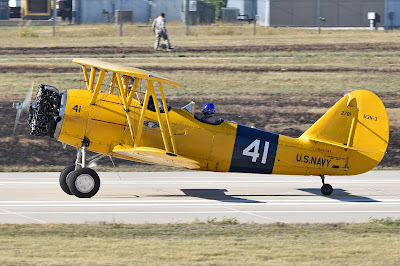 Photo Credit: Alan Wilson, Creative Commons LicenseI have wanted to fly since my very first airplane ride. It was 1928 and I was five years old. The Curtis JN-4 “Jenny” was a two-seater biplane, with controls at both places. Daddy put me in the front seat where he could keep an eye on me as he flew. I was bundled up and wearing goggles that were way too big for me. I probably looked like I had bug eyes. After buckling me in and giving me stern instructions, “Don’t touch anything!”, dad started that throaty Hispano-Suiza 8 engine. Being a boy, I wasn’t scared by the noise—I loved it. The noisier the better! As soon as the ship lifted off the ground, I was hooked. Whatever it took, whatever I had to do, someday my future was going to include a cockpit.
Photo Credit: Alan Wilson, Creative Commons LicenseI have wanted to fly since my very first airplane ride. It was 1928 and I was five years old. The Curtis JN-4 “Jenny” was a two-seater biplane, with controls at both places. Daddy put me in the front seat where he could keep an eye on me as he flew. I was bundled up and wearing goggles that were way too big for me. I probably looked like I had bug eyes. After buckling me in and giving me stern instructions, “Don’t touch anything!”, dad started that throaty Hispano-Suiza 8 engine. Being a boy, I wasn’t scared by the noise—I loved it. The noisier the better! As soon as the ship lifted off the ground, I was hooked. Whatever it took, whatever I had to do, someday my future was going to include a cockpit.In 1928, dad (D. K. as he was known to his friends) was fully invested in the fledgling aviation industry. He had been a sophomore engineering major at Georgia Tech when the Great War interrupted his academic plans. He enlisted in the US Naval Reserve Force (USNRF) in June of 1918, when World War 1 was creating a lot of widows. Fortunately the war ended before he got to Europe.
Naval budgetary issues produced a massive drawdown of the military when the war ended, and dad was squeezed by it like everyone else. He was honorably discharged from the Navy in September of 1921.
As the years rolled and the Depression set in, work for most people became difficult to find. Thankfully, dad’s rare aviation skills kept him employed at one job or another. He was a certified flight instructor, a commercial-rated pilot, a certified aircraft mechanic, and a ground school instructor. For a time, dad was a salesman dealing with Aeromarine-Klemm aircraft and Salmson and LeBlond aircraft engines. I suppose dad could lay claim to being the first “equal-opportunity” instructor, because he taught both men and women to fly.
**********
So, there I am at Georgia Institute of Technology in my sophomore year, studying mechanical engineering. Late at night on December 7, 1941, my roommate and I were in the dorm studying for semester finals when we heard a news flash that Pearl Harbor had been attacked. We looked at each other across the room, snapped our books shut, and said, “Let’s get with it!”
He enlisted right away in the Army Air Corps. Unfortunately, I had to wait until May of ‘42, when I was old enough to enter the Navy Reserves in the aviation program. It did not occur to me at the time, but my dad had virtually the same experience at Georgia Tech in 1918. Same school and course of study, same navy, same intention to fly. Different war.
**********
“Greetings, gentlemen. You people can set your bags on the ground, right there,” said the grinning man as we got off the bus. We had pulled up to a building that looked a lot like a barracks. We were in Athens at the University of Georgia, where we would get pre-flight ground school instruction as well as physical training for strength conditioning. We were all a little anxious, not quite sure what to expect. Had it not been for that nervousness, I probably would have detected the malicious gleam in the man’s eye.
“No one will disturb them. Very well. Now, line up here behind me, gentlemen. Very good. Follow me, please.”
That was the last time he was polite to us for the next three months. As it turned out, he was our physical training (PT) drill instructor. We didn’t know that at the time, however. He simply had ambushed us as soon as we disembarked from the bus.
He took off running at a good clip. We all looked at each other and shrugged our shoulders. We’re in street shoes and traveling clothes. The man jogged about 20 yards, looked back and saw no one following.
“LADIES,” he barked, “I SAID, FOLLOW ME! NOW!” He turned and began running even faster.
Oh, boy, I thought. What have I gotten myself in to? There was a reason I chose naval aviation and not the army. I’d had enough of ground pounders in Army ROTC at Georgia Tech. I wanted to be a pilot, not a grunt! I didn’t think running or marching would be part of the package! Boy, was I wrong!
We began chasing after him in our street shoes and traveling duds. As he ran, he shouted at us, “You are in Company H, Platoon 2. Remember that, because when we post the training schedules, you will be responsible to be in the right place at the right time, dressed appropriately. Nobody here is your mama or poppa. You want to fly for the Navy? Well then, you will learn to be responsible starting right now. You WILL be on time for every event on your schedule. If you are even one second late to ANYTHING, I will bless you with an extra three mile run.”
He was merciful that day, if you count stopping short of killing us as merciful. We ran (at a near sprint) only two miles before he led us back to our luggage and the barracks that would be our home for the next three months. Some of the guys puked, and we all had blisters from running in our street shoes. It didn’t really bother me, because I was in pretty decent shape as a runner. At least, I thought I was. As it turned out, the PT did challenge me at times.
The physical requirements necessary to graduate out of ground school included a provision to swim twenty laps—one thousand meters—in under a certain amount of time. The pool was fifty meters long with ten lanes. There were enough of us taking the swimming test that they split the pool into two five-lane sections. One section had the swimmers being tested, the other side was reserved for warm-ups for the next cadre. They would alternate, side to side, in order to run the groups of swimmers through the tests faster.
Okay, I’m ashamed to admit this next part. As it happened, I was climbing out of the pool in lane six after having done a two-lap warmup at the same time as the cadre in lanes one through five was emerging from the pool at the end of their thousand-meter test. It wasn’t anything I had planned—it just happened. In all the noise and confusion, the ensign monitoring the swimming test marked me down as having completed the twenty laps. I never said a word.
We had to pick a sport to participate in during the three months, and frankly that was a good idea, as it gave us cadets a chance to let off some steam. Although soccer was tempting, I decided that boxing sounded like fun. I’ve never been much of a scrapper, and I figured I’d learn some useful moves and combinations in the manly art of fisticuffs. My enthusiasm for the sport lasted until my second sparring session. My partner was quite a bit more experienced than me and was teaching me how to block punches. Only I missed and he didn’t, resulting in a broken nose and blood all over the floor.
I was really good at math and physics which helped a lot in ground school. As a cadet whose dad had been a pilot practically since the beginning of flight, ground school was a piece of cake for me. I pretty much aced the classes. However, we didn’t do any actual flying in ground school so I was really glad when this phase of training came to an end.
On October 13, 1942, I graduated from Pre-Flight School and was ordered to Primary Flight School at Lambert Field in Missouri. That is where my actual flight training would begin.
**********
I arrived at Lambert two days before I had to report. I wanted to get the lay of the land and find my way around the base. It was unusually cold for late October, so one of my first stops was the commissary. I wanted to draw my issued gear before the next class of cadets arrived. I’d heard a few stories that the Navy was ramping up the training programs so quickly that the commissaries were running out of stock; some of the guys had to wait a week or two to get their stuff.
“What can I do you out of,” the civilian clerk asked with a lazy midwestern drawl. He looked a little older than me, maybe twenty four, twenty five.
“Huh?”
“Whaddayah here for?” the clerk asked with a tone that spoke of weary exasperation.
“Primary Flight Training,” I answered with some degree of pride. “I want to pick up my gear.”
“ID,” he said, holding his hand out. He checked my name against a list and nodded. “Gotcha right here, Cobb. You’re a little early, ain’tcha?”
I shrugged and nodded. As he disappeared into the aisles of shelves behind him to collect my gear, I noticed that he was limping.
“Didja hear that Ghormley’s out, Halsey’s in?” he called from somewhere back in the store room.
“What? Umm, no. I’ve heard of Admiral Halsey, but who is Ghormley?”
He walked back to the counter and set my gear down, pushing a requisition chit at me to sign. “Yeah,” he said, “happened a week or so ago. Ghormley was commanding in the south Pacific. Guess the brass didn’t like how he performed at Guadalcanal, so they turned the operation over to Halsey. Halsey will kick those Jap butts, for sure.”
He stared at me for a moment and shook his head.
“What?” I asked.
“Make the most of this, buddy. I’d love to be in your shoes right now. It’s a great opportunity to learn to fly and to serve the country. Count yourself fortunate. I tried to sign up—no one will take me. Club foot,” he explained. “So figured I could at least serve by clerking here at Lambert, keep ‘em from wasting some Navy puke on stuff a civie can do.”
“Thanks,” I nodded. “I’ll do my best.”
**********
“Cobb!” the flight instructor barked. “You’re with me. I’m Lieutenant Virnig. Let’s get you up in the air. Got your logbook?”
“Yes, sir.”
“Any air time yet?” he asked as we walked across the tarmac towards a bright yellow N3N-1 biplane. I’d heard dad chuckle about these airships, calling them the “Yellow Peril.” The “Peril” part wasn’t about the airplane—it was a solid ship that handled well—the peril part had to do with the fact that it was mostly used as a trainer, and student pilots weren’t the safest of fliers.
“Nine hours, sir, with my dad. He’s a flight instructor and former naval aviator.”
“What ship?”
“A Curtis Jenny. War surplus.”
“I’m impressed,” Virnig said. “The Jenny is a good airplane. Did your dad teach you anything about flying?”
“Ground school stuff only, sir. He said he didn’t want to teach me anything that the Navy might want me to unlearn. So those nine hours were just as a passenger.”
“You got a smart daddy, son. Did you log your nine hours?”
“No, sir.”
“Well, then, we’re starting from scratch.”
Virnig took the rear seat and put me in the front. We strapped in and took off with Virnig at the controls. We flew for about ninety minutes, during which he had me get the feel of the controls. I took the stick, tried the rudder pedals, and learned how to adjust the throttle. I was grinning the whole time.
Later that day we flew again, this time in an N3N-3. The N3N-3 was a slightly upgraded model from the N3N-1 and used the 240 horsepower Wright J-6-7 radial engine. The N3N-1 had the J-5, which only produced 220 horsepower. The N3N-3’s vertical stabilizer was a little different, too, and there were a few other minor changes.
On this hop Virnig began giving me basic instructions about recovering from stalls and spins. It’s a little nerve wracking when the airplane starts dropping like a brick. I was really glad Virnig had his hands on the controls. What he was teaching me is that, if you keep your cool, and know what to do, you can recover from these kinds of problems. It’s when you panic that stalls and spins become deadly. Toward the end of this flight, Virnig stalled the aircraft and turned the controls over to me to recover it. Well, I’m still alive, so I must have gotten something right. Virnig landed the ship, for which I was secretly thankful.
After we climbed out of the cockpit, he said, “You did okay today, Cobb. After the first couple of screw-ups, you got the hang of it.”
“Thanks, sir. It just kind of gives me the willies when we’re a thousand feet up, and the ship starts behaving like a cinder block.”
“Hey, if that doesn’t give you a shot of adrenalin, you’re not human. But you learn to master your fear and think your way out of the situation, pushing the nose down, applying the proper rudder. But if you lose your head, a stall or a spin will kill you. That’s why we always practice at altitude—the ground comes up awful fast and you need time to recover.”
I looked back at the aircraft as we walked toward the hangar. “So who makes these beauties, anyway, sir? Boeing? Martin? Grumman?”
“No, not the N3Ns. We do,” Virnig said. “We, meaning the Navy. There’s a factory in Philly that pumps ‘em out for us. Navy owns it—lock, stock, and barrel.”
“The Navy has its own factory? That’s odd. How did that happen?”
We stopped and turned, looking at the flight line of trainers parked on the tarmac. Virnig pulled out a Lucky Strike and his Zippo and lit up. After he exhaled a cloud of smoke, he looked at me. “It was WW1, Cobb. The Army soaked up all the private manufacturing capacity, so the Navy built it’s own factory. Things have changed since then. Now everyone is building for us: Grumman, Boeing, Douglass. Nuts, even outfits like Ford have turned their production lines from cars to bombers.”
“I reckon war changes everything. It sure changed my direction,” I said.
He nodded. “I reckon so. See you here tomorrow, 0900.”
**********
I could feel Virnig pushing the stick forward, even as I heard him shouting at me through the speaking tube. “Doggone it, Cobb! Push the stick forward. Otherwise you’ll never get the airspeed to lift off. It’s like you’re stalling the aircraft, even though we’re still on the ground!”
The N3N was wallowing down the runway, nose too high. Virnig took over before we ran out of runway. Once we got in the air, he gave the controls back to me.
“Remember your basics from ground school, son,” he said to me, noticeably calmer, as I started a climbing turn. “You need to achieve takeoff speed before the aircraft will lift off. When the plane’s nose is too high, it creates greater air resistance, and the airplane can’t achieve takeoff speed. The solution is to keep your nose low until you have plenty of airspeed to rotate.”
I nodded, showing that I’d heard him. This was my second takeoff today, and I’d made the same mistake on both of them. I was angry with myself and rattled.
Virnig could tell I was upset. “Take it around, land, then taxi back to the beginning of the runway, and let’s try again.”
I nodded again, checked the traffic around me, and got into the landing pattern. My landing was nothing to write home about, but it wasn’t terrible either. I taxied back to the beginning of the runway and stopped short, to let two students take off ahead of me. When it was my turn, I did a visual check for incoming traffic, and was rewarded with a “Good boy.” Jamming the throttle forward, I started rolling. Although it went against my natural inclination, I forced myself to push the stick forward, and held it there as the ship gained speed.
“Good, good, son. Not yet… not yet… okay now, ease the stick back a little. There! See how easy that was,” Virnig said through the voice tube.
I was grinning again. It was a much better takeoff, and I noticed how much more responsive to the controls the N3N was at the higher speed.
After another ninety minute hop and an acceptable landing, I taxied the N3N back to the flight line and shut her down. We both disembarked from the airplane, and I stood waiting, as Virnig wrote up the evaluation.
“You’re doing okay, Cobb, and you’re improving. We’ve got a lot to work on, but you catch on fast.”“Yes, sir,” I responded, secretly disappointed. I’d thought that I’d be further along by now, but it was all turning out to be more complicated than I had ever imagined. It gave me a renewed appreciation for how skilled dad was in his Jenny. I was really wrestling with simple maneuvers like banking the airplane in a turn. But it wasn’t simple! When you bank, the airplane loses altitude unless you goose the throttle slightly or pull back on the stick. And if you don’t coordinate your pedal movements with your stick movement on turns, you wind up skidding instead of banking. When you level off, you have to retard the throttle or you’ll pick up speed, which causes the airplane to climb. Will I ever master this?
“Okay, son, you’re flying again on Tuesday. Meet me here at 0900.”
“Yes, sir.”
**********
Over the next two weeks, I cringed as I saw Virnig’s comments on my evaluation sheets.
On November 4: “Always fails to throttle back after leveling off. Can’t remember to push stick forward on takeoff.”
On November 11: “Always takes off with left wing low. Breaks glide OK but doesn’t continue to bring stick back for a landing.”
This discouraging remark was on November 12: “Has trouble keeping plane straight and wings level on takeoff. Tries hard but forgets to do the right thing at the right time.”
I’ll tell you whose tail was dragging, and it wasn’t the N3N’s. It was mine. I was beginning to think I’d never be ready to solo. I even wondered if Virnig was going to wash me out of the program.
I got up on Friday morning and didn’t feel too spunky. I wondered if maybe I was coming down with something. I went for an early morning run, showered, geared up, and went to the cadets’ mess hall. Sat with a couple of my buddies, and we were all pretty down in the mouth about the instructor evaluations we were receiving. That actually cheered me up a little, knowing I wasn’t the only guy with my tail between my legs.
“You know what today is, guys?” Johnson asked mournfully. I’d finished breakfast and was about to head for the flight line. I was meeting Virnig at 0900 for today’s hop.
“Friday, genius. Why do you ask?” Carpenter answered.
“Yeah, but it’s Friday the 13th,” Johnson replied. “I don’t know about you guys, but I sure don’t need anymore bad luck in the cockpit.”
“That goes for me, too, Johnson,” I said. “I’ve had enough problems flying, I don’t need any new ones.”
Carpenter looked at me and said, “Buck up, Cobb. My dad used to say, ‘Son, any hop you can walk away from was a good hop.’”
I chuckled. “Think my daddy said the same thing to me.” I checked my watch. “Anyway, if you boys are scheduled at 0900, we’d better get a wiggle on.”
Virnig was waiting for me at our aircraft. “You ready, Cobb?”
“Yes, sir. Ready and rarin’.” I didn’t feel good, but I wasn’t about to tell him that.
“That’s the spirit. Show me some good stuff today, boy.”
He put me through my paces, and about the best thing I can say is that I didn’t crash the airplane. After we’d been up for just shy of an hour, he called to me through the speaking tube and told me to land and taxi to the flight line. I felt crushed, because he was ending our ninety minute session half an hour early. I wondered what I’d done wrong.
My landing was actually pretty good and so was my taxiing. When I cut the engine we both got out of the plane, and he marked his evaluation sheet.
“Want to know how you did, Cobb?” Virnig asked.“Yes, sir,” I said. I was already feeling worse physically, so I braced myself for what I was about to read. There were only three words: “Safe for solo.” I whooped loud enough to turn heads all the way down the line.
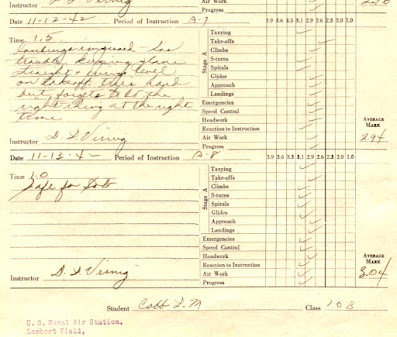 Photo: Cobb family collection
Photo: Cobb family collectionVirnig grinned at me. “Go hit the head if you need to. Come back here immediately and wait for your check pilot. It’s going to be Lieutenant Rothchild. You’ll take him up for a check ride. He’ll have the final say as to whether you are ready to solo.”
I couldn’t believe it, but my check ride was nearly flawless. So much for bad luck on Friday the 13th. Rothchild approved me for solo and gave me an upcheck, meaning that he graduated me from Stage A flight training into the Stage B training.
Although I was riding on cloud nine, I felt awful physically. As soon as I could get away from the flight line I went to sick bay. The doctor checked me over and pronounced, “No flying for you until you’ve got this cold under control.”
“But sir, I’m supposed to solo tomorrow.”
“Yes, and I’m supposed to make admiral tomorrow, but that won’t happen either. It’s life, son, get used to it.”
I looked at him, then saw the captain’s bars on his coat on the hall tree. “Captain, sir, are you really about to be promoted?”
He rolled his eyes. “It was a joke, son, a little bit of sarcasm. You’re not going to fly tomorrow. If you think you’ve got a headache now, just wait till you’re at 3000 feet or so. It will hurt so bad you’ll probably black out, and that could really ruin your day.”
He gave me medicine, and I went straight back to the barracks and straight to bed.
“Look, Doc, I’m feeling much, much better this morning. Headache is completely gone, and I have a lot more energy than I did yesterday.”
He looked at me, unimpressed. “Care for a kleenex, son? Your nose is dripping.”
I sneezed and blew my nose. “Doc, now it’s just a runny nose. You’ve got to let me fly.”
He just looked at me.
“Please, sir.”
The man must be a good poker player, because he just stared at me without answering, his face giving away nothing. He pointed to the kleenex box, and I blew my nose again.
“Listen, Doc, I… I’ll, um… Ah! I promise I won’t go any higher than 1500 feet. I’ll stay below that.”
He sighed. “You promise?”
“Yes, sir, scout’s honor.” It sounded dumb as I said it, but I was desperate.
“You’re in the Navy, son, not the Boy Scouts, and you’ve been entrusted with some very expensive equipment—only the good Lord knows why.
“If you break your promise, Cobb, I’ll throw you in the brig. Understood?”
“Yes, sir, absolutely.”
“Okay. You’re cleared to fly. But if you’re gonna crash, don’t run into anything important.”
“Got it, sir. And thank you.”
He just raised his eyebrows and shook his head.
Grinning, I turned to go.
“Hold up, Cobb.”
I turned around, “Sir?”
He pointed at the box of Kleenex. “Take it with you.”
And that is why I was flying with one hand and blowing my nose with the other for my first solo flight. I kept my promise to the doctor, and I graduated to the next stage of Primary Flight Training.
August 17, 2023
Book Review: The Toxic War on Masculinity
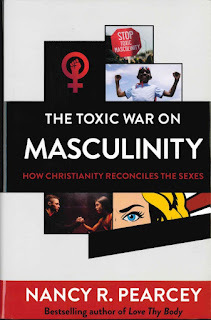
Nancy Pearcey is one of the premier Christian thinkers of the modern age. At one time a student of Francis Schaeffer, she has extended and elucidated the thought of Schaeffer into the current cultural morass, particularly Schaeffer’s analysis of the secular idea of upper- versus lower-story truth. Also like Schaeffer, she does an excellent job of tracing the evolution of cultural trends through history, providing numerous footnotes—no less than 775 in The Toxic War on Masculinity . This excellent volume demonstrates that she does not shrink back from confronting both secular and Christian cultures with the sharp edge of her intellect.
Pearcey begins with full disclosure as to why she wrote the book. Her father lived two different lives: in public a respected university professor and in private an angry, abusive father. After initially rejecting Christianity because of her father’s hypocrisy, a sojourn at L’Abri showed her what true Christianity looks like, resulting in her conversion to genuine Christianity. The book serves as her way of tracing the cultural and psychological factors that produced an abusive man like her father and the current broad-brushed societal tendency to attribute such bad behavior to all men.
Chapter one is devoted to exploring where the modern culture is with regard to its view of men. Pearcey brings forward a contrast she’ll use in the rest of the book: “real men” versus “good men.” So-called real men kowtow to twisted cultural expectations of men (such as the expectation and encouragement of bad behavior), whereas good men pursue the best and most noble aspects of masculinity.
Exploding the myths begins in the second chapter, in which she quotes suprising statistics regarding men and abuse and divorce. Pearcey examines the studies more closely and reveals that while nominal Christian men score in the highest category of abuse—which is what is usually reported in the media—committed evangelical Christian men actually score in the lowest (which you will never see in the media).
In the third chapter, Pearcey unfolds what a truly biblical marriage looks like, along with biblical concepts of headship and submission. She demonstrates that it doesn’t look anything like the slanderous stereotypes of the secular culture.
The second part of the book (nine chapters) traces “how the secular script turned toxic.” In these lavishly-documented chapters, Pearcey follows the progression—and destruction—of family life from the original agricultural model of every family member working together at home, through the Industrial Revolution that took men out of the home, thus weakening or eliminating the father’s beneficial influence. The absence of fathers (who were now working long hours in the factories) meant that they were not home to teach their sons skills and moral discipline and to mold them into responsible men. Absence from home and hearth left men open to temptations (particularly illicit sex and alcoholism) that before had been under better control. Men began behaving badly with the result that, comparatively, women were placed on a moral pedestal of righteousness. Men behaving badly, i.e. “real men,” became the expectation and somewhat of a self-fulfilling prophecy. Men lost interest in attending church, with the result that most of the attenders in the average church were women.
Pearcey points out that one of the consequences of this terrible trajectory is that Christianity came to be seen as a religion of women. Men wanted nothing to do with it because it seemed feminized. The image of the “real man” became stamped in the culture; the “good man” was something no self-respecting man wanted to be part of.
In chapter ten, Pearcey examines the reaction against feminized Christianity that developed in some quarters. A so-called “muscular Christianity” was promoted in order to redeem “manliness.” Churches began to host events of interest to men (fight clubs, gun giveaways, etc.) in an attempt to draw men back into the sanctuary. Fundamentalism got involved, with macho preachers engaging in violent antics on stage to assert that Christianity was for real men. Just as a pendulum that swings in one direction soon returns to the other, this began a backlash against women. Whereas in the 19th century women were thought of as superior, in the 20th century they began to be thought of as inferior—weak creatures whose primary responsibilities were bearing children and being subservient to their husbands.
Secular culture rejected the polarizing fundamentalism. In chapter eleven, Pearcey unfolds the path that led to men (dads in particular) being presented by Hollywood as dimwits. Feminists poured gasoline on the fire: “men are unnecessary,” they claimed. Out of the resentment that developed on the male side came the playboy and pornography culture.
It’s easy to critique culture—but advocating solutions is harder. Nancy Pearcey does a great job on the solution side in chapter twelve, entitled “Bringing Fathers Back: Fix the Workplace, Fix Your Family.” She gives many creative ways to bring the unity of the home, father and mother together, back to the fore.
The third section of the book is basic triage: how to fix the problems that develop when “Christian Men Absorb the Secular Script.” Two excellent chapters are devoted to fixing broken marriages and dealing with abuse in Christian homes.
Pearcey is the real deal: a Christian and biblical thinker, a scholar, and one who has suffered under an abusive father. She brings her intellect, her scholarship, her faith, and her experience to the table and shares it with the reader. The book includes a study guide at the end, suitable for individuals or groups. Nancy Pearcey’s The Toxic War on Masculinity is an outstanding book and well worth your time.
Five stars—highly recommended.
July 24, 2023
Why Christians and parents should vote YES ON ISSUE #1 IN AUGUST and NO IN NOVEMBER
Ohioans have two opportunities to protect parental rights in the nextfour months. In August, we must decide on Issue #1, an amendment thatwill protect the Ohio Constitution from being too easily tamperedwith. Issue #1 accomplishes that protection by raising the bar forthe passage of an amendment ballot initiative from fifty percent tosixty. This helps to protect our Constitution from being crowbarredby special interests and the progressive movement. I have alreadyexposed the deceptive claims of those opposing Issue #1 and havewritten on why you should vote YES on Issue #1 in AUGUST. You can read that article here.
In November, the ballot will contain another proposal to amend theOhio State Constitution. This amendment is entitled, The Right toReproductive Freedom with Protections for Health and Safety. I’murging Ohioans to VOTE NO to this amendment initiative IN NOVEMBER.This amendment would be a disaster to parents and children if itshould pass.
A brief examination of the actual text of the proposed amendment willeasily show why this amendment is a really, really bad idea. Here’sthe first paragraph:
Every individual has a right to make and carry out one's own reproductive decisions, including but not limited to decisions on:
contraception;
fertility treatment;
continuing one's own pregnancy;
miscarriage care; and
abortion.
Let’s examine it part by part:
Notice that while there are five specific areas of “reproductive decisions” identified, the explicit language opens it up to other not-identified areas of “reproductive decisions” when it says “including but not limited to”. What might those other areas include? Gender transition is one obvious answer.
Notice that there is no definition of the age of the individual covered by this amendment. It simply says, “every individual.” According to this amendment, a minor, a child of any age, has the right to “make and carry out” their own reproductive decisions. This means your twelve-year-old daughter has a right to an abortion, no matter what you as a parent might say or do. You are out of the picture. It means your seven-year-old son has a right to decide to transition as a girl—no matter what you as a parent might say or do.
Am I manipulating you with a scare tactic? No, indeed. Haven’t you been reading the news about what is ALREADY HAPPENING? Anyone who follows the news knows that the progressive movement has been successful in erasing parent’s rights in the matter of abortions, gender identity, and gender transitions of their children, aided and abetted by progressive school boards. School districts are hiding from parents their children’s attempts to transition. Parents are being accused of child abuse if they refuse to allow their children to transition, or if they even use the “wrong” pronoun.
No, this isn’t a scare tactic—it’s a warning that in November, this erosion of parental rights will become part of the Ohio Constitution. Unfortunately, this is a matter in which past performance DOES guarantee future results. Parents have no rights in this amendment. And because this is an amendment to the Constitution and not simply normal legislation, if it passes, a court can rule that the amendment invalidates any prior legislation recognizing your rights as a parent in these areas.
By the same token, this amendment makes abortion wide open for any and every reason, at any and every point in pregnancy: “Every individual has a right to make and carry out one's own reproductive decisions”. The restriction placed on abortion in the case of fetal viability, found later in paragraph B, is elastic: if the treating physician believes the mother’s “health” is at stake, abortion is permitted at any point of gestation. The expression, the mother’s “health,” has not in recent years been restricted to her physiological health but has been expanded to her mental and emotional health. This suddenly becomes a “right” to abortion at any point simply if the mother doesn’t want the child.
What about paragraph B? Here’s a portion of the actual text:
The State shall not, directly or indirectly, burden, penalize, prohibit, interfere with, or discriminate against either:
An individual's voluntary exercise of this right or
A person or entity that assists an individual exercising this right,
unlesstheStatedemonstratesthatitisusingthe leastrestrictivemeansto advance the individual'shealthinaccordance with widely accepted and evidence-basedstandardsofcare.
This means a school teacher, guidance counselor, or anyone else, even a boyfriend, could assist your teenage daughter to get an abortion without your knowledge and without your consent—even over your opposition. It means some third party could seek to convince and then assist your minor son or daughter to secretly attempt a gender transition, without your permission and without your knowledge They would face no legal consequences for it.
You might argue that these are extreme slippery-slope possibilities,and that reasonable people would not interpret the law in thiswild-west fashion. You’re wrong about that, and I can easily proveit.
Think about this: when it was originally passed, Title IX of theEducation Amendments Act of 1972 was intended to provide womenthe same opportunity to participate in sports that men had. Those whopassed the law knew what a woman was. They never intended the law toenable biological males to compete against women, use women’slocker rooms and showers, etc. And look where we are now, preciselybecause the progressives HAVE taken the language of the law to anunimaginable extreme.
Regarding the slippery-slope, what sane individual of twenty yearsago could have imagined “Drag Queen Story Hour,” or “menchest-feeding babies,” or “pregnant people,” or custom-tayloredpersonal pronouns? Do you really think the progressive moment willstop short of pressing the vague language of this bill all the way tothe breaking point? I don’t. They have ALREADY demonstrated theywill take the inches given to them and turn them into miles.
For the sake of parents and children, this amendment must bedefeated. It will be easier to defeat if you VOTE YES ON ISSUE #1.
VOTE YES ON ISSUE #1 IN AUGUST!
VOTE NO ON THE REPRODUCTIVE AMENDMENT IN NOVEMBER!
July 19, 2023
Don't be fooled about Issue #1!
There is a great deal of confusion circulating in Darke Countyregarding Issue #1. There’s also a great deal of deception aboutit, but more on that in a moment.

The progressives areplaying a two-step game with the Ohio Constitution: one step inAUGUST (defeating Issue #1), and one step in NOVEMBER (passing theThe Right to Reproductive Freedom with Protections for Health andSafety amendment to the Ohio Constitution).
Let’s talk aboutthe second step first, the NOVEMBER step.
The progressives areproposing an amendment to the Ohio Constitution that will putchildren and the unborn at risk. This amendment has the very realpotential of taking a child’s gender identity, medical gendertransition decisions, and abortion decisions, out of the hands of theparents. The language of the amendment is intentionally very vague,and open to wide-ranging interpretation. This amendment will be votedon in NOVEMBER.
I will write asecond article in a few days explaining why this terrible“Reproductive Freedom” amendment is an unmitigateddisaster for parents and children, and must be defeated. Asthings stand now, all that is necessary for that terrible amendmentto become enshrined in the Ohio Constitution is a simple majorityvote (fifty percent plus one vote) in NOVEMBER.
Which brings us tothe first step. The progressives want to defeat Issue #1 in AUGUST.They want you to vote NO to Issue #1. Why?
Because Issue #1raises the bar for amending the Ohio Constitution. In other words, ifIssue #1 passes in AUGUST, it will make it harder to pass theReproductive Freedom amendment in November.
I’ll expose theefforts to mislead the voters practiced by these people in just amoment, but first I will state the matter simply:
YES on Issue #1 inAUGUST will make it harder for the progressives to win in NOVEMBER.
NO on Issue #1 inAUGUST will make it much easier for the progressives to win inNOVEMBER.
Issue #1 is aboutmaking it more difficult for special interests groups to trample onthe rights of the rest of us. At the present time, a mere majorityvote (fifty percent plus 1 vote) is all that is required topermanently amend the Ohio Constitution. Issue #1 would have twoprincipal effects: it would raise the bar to sixty percent. It wouldalso make it more difficult to get a proposed amendment initiative onthe ballot, by requiring the signatures of at least five percent ofthe voters in every county in the state (five percentbased on the total number of votes in the last gubernatorial electionin each particular county).
Before we expose thebasic dishonesty of the ad campaigns that the progressives arepublishing, let’s take a moment to understand the relationship ofthe Ohio Constitution to legislative acts. The Constitution is thecitizen’s first line of defense against unwise, unfair, orunconstitutional legislation. When a legal case is brought thatchallenges a state law, the state judiciary uses the text and wordsof the Constitution to determine whether the law in question shouldbe upheld, or struck down in whole or in part.
If citizens believethat the Constitution is not adequately protecting their rights, orbelieve that laws have been passed that are unjust, they can attemptto gather enough signatures to put a constitutional amendmentinitiative on the ballot to correct the problem. Once the amendmentis on the ballot, if a sufficient number of citizens vote for it, itbecomes part of the Constitution, providing boundaries around whatthe Legislature may and may not enact.
A well-writtenConstitution protects the rights of the citizens, including thehelpless and vulnerable, against powerful individuals or specialinterests whose priorities collide with those of the citizens.Consequently, the Constitution is not a document that should beeasily tinkered with. It should be protected by making it harder toamend.
What about mycharges of deception?
#1. The League ofWomen voters is posting an advertisement entitled, “ProtectOhio’s Constitution, Vote No on Issue 1.” It is true thatthe current Constitution can be amended by simple majority. Issue #1would change that, raising the bar from 50% to 60%. The higherrequirement does a better job of protecting the Constitution frompowerful special interest groups. At the very least, League’s claimis misleading. Voting down Issue #1 does not protect theConstitution, but leaves it in its current state of vulnerability topowerful, well-heeled special interest groups, like PlannedParenthood and other sexual revolutionaries.
#2. That same adclaims that passage of Issue #1 eliminates majority rule in Ohio. Itdoes not. Another ad claims that Issue #1 would allow 40% of votersto “make decisions for the rest of us.” Totally false. Normallegislative acts in Columbus would continue to pass with a simplemajority, as they do now. Issue #1 would not change that atall.
If the progressiveswant laws that favor their ideology, they can propose and pass themin the Legislature with a simple majority vote. Issue #1 will notchange that! But they should not be allowed to tinker with theConstitution on the basis of a simple majority. By the way, askyourself, why do the bylaws of the League of Women Voters require atwo-thirds vote to change them, when that same organization wants aState Constitution protecting the rights of millions to be changed atthe whim of a simple majority? What happened to “one person, onevote”?
And as long as we’retalking about majority rule, ask yourself: has there ever been a timein America where a majority oppressed a minority? How did that turnout? Not good at all. Do you really think it’s a good thing toenshrine that possibility of oppression in the Ohio StateConstitution? I don’t.
#3. That same adclaims that Issue #1’s passage “will render the ability topresent a voter-led petition virtually impossible.” That’s atotally false claim. Issue #1 only raises the bar regarding petitionsthat propose to amend the Constitution—but not for other petitions.The text of Issue #1 is explicit: “Require that any initiativepetition filed on or after January 1, 2024 with the Secretary ofState proposing to amend the Constitution ofthe State of Ohio be signed by at least five percent of the electorsof each county based on the total vote in the county for governor inthe last preceding election.”
The problem for theprogressives is the requirement in Issue #1 that sufficientsignatures be collected from ALL of Ohio’s counties. Issue #1 doesin fact require that, but it only applies to initiatives toamend the Constitution, not to other ballot initiatives. Ibelieve this portion of the Issue #1 language would actually benefitall Ohioans, not just those in large cities. Ask yourself: does itoften wind up being the case that the voters in Columbus orCincinnati or even Dayton have a very different set of values fromthe voters in Darke County? Do you want a few large cities to be ableto crowbar the state Constitution in liberal, progressive directions?Wouldn’t it be more fair if ALL the counties of the state had avoice as to whether or not an amendment initiative to theConstitution was placed on the ballot? This is what Issue #1 wouldaccomplish.
I’m voting YES forIssue #1, and so should you.
In my next piece, Iwill explain the disaster that will face Ohio parents in November ifIssue #1 does not pass.
VOTEYES FOR ISSUE #1
ANDSHARE THIS POST WITH YOUR FRIENDS!
June 20, 2023
Need a great beach book?
Howabout some action-packed page-turners, exciting stories from a Christian worldview? Both adults and teens will find these talesfascinating. Youwon’t have to wash your brains out after reading one of theseexciting novels—but you will find it hard to put them down. Of hisnovels Cobb says, “If I don’t make you miss yourbedtime, I’m not doing my job.”All titles are available locally (Greenville, OH) at the Bread ofLife Bookstore, or on Amazon in print and Kindle format. You can findCobb at chcobb.com.

Falcon Down (military/espionage thriller,book one of four)
Sometimeswhat you don’t know can hurt you!
Thechief test pilot for a highly classified F-16 weapons-developmentproject, Major Jacob “Falcon” Kelly is shot down and captured bythe Soviet Union in a hi-tech kidnapping during the Cold War. Theyintend to interrogate him to learn the secrets of the new weapon. Hiscaptors have detained him at a secret GRU facility in Siberia.Holding on to him might prove difficult, however, because Kelly hassome skills of which they are unaware . . .
KirkusReviews: “Cobb has clearly done his research onmultiple counts and, like Tom Clancy or Dale Brown, masterlyintertwines military technology and behavior into a tightly plottednarrative in which every development follows logically and smoothlyfrom what came before. This deft touch extends to the characters . ..”
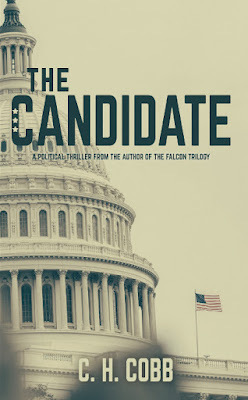 (political thriller)
(political thriller)Itbegan as a blog. It became a political firestorm.
HenryMarshall is a principled Christian conservative blogger who isconvinced that both major parties have abandoned the Constitution.His intention is to be nothing more than a political gadfly, but hisfriends won’t allow him to stay on the sidelines, and his enemiesdon’t intend to allow him to live.
Journalist/author TJ Martinell:“Penned before the 2016 election cycle . . . , TheCandidate is a political thriller that unwittingly earns aplace within the alternative history genre for its exploration of howfar a man can go armed only with a message – and how far thosewithin the establishment will go to stop him. . . . [M]any of theaspects of the plot seem prophetic, rather than slightly fanciful.
A pastor by trade, Cobb’s writingreflects extensive background knowledge of mainstream media,political strategy, the military, and of course constitutionalhistory; . . . . The technical preciseness gives vital story subplotsa sense of authenticity and realism.”
Outlander Chronicles: Phoenix (post-apocalypticaction/adventure, book one of three)
(post-apocalypticaction/adventure, book one of three)
Fromthe ashes of a world past . . .
Eighty years after a smallpoxpandemic has reduced the global population to eight million, a youngman (Jacen Chester) experiences the tragic deaths of his entirefamily and community. Wrestling with grief and anger, he commitshimself to establishing a new community (Phoenix) that will advancebeyond merely subsisting on the remains of the former world.
He meets a mysterious wanderer whodecides to help him accomplish his dream. Together the two gather asmall community and set their sights on the empty interior of thecontinent—1800 miles away—where they can escape the murderousgangs of the east and pursue their project in peace.
But hatred and bitterness from withinand lethal attacks from without threaten to destroy the growingPhoenix community. A painful lesson in forgiveness and tolerance isrequired to save Phoenix from itself.
Captivated Reading Book Blog: “With two incredibly strong main characters, Phoenix tells astory of a world lost and people who are desperate . . . I wascompletely enthralled in this story from beginning to end.”
Amazon Reader Review: “Iloved reading this book and I can't wait for more of the story! Itgave me so much to think about, which I love in a book, and it was anexciting read, too! It raised ideas I had never thought about before,as well as presenting familiar ones in a new way. Cobb is veryeffective at evoking a world that is both radically different fromour own, and also not so distant in possibility. . . . Although Idisagree with most of Cobb's views as I ascertain them from thestory, I really enjoyed the debates and discussions the charactershave, which I think says a lot about Cobb's talent as a writer aswell as his even-handedness as a thinker. . . . Bring out a sequel,please!!!”
APrayer of Moses: ADevotional Commentary of Psalm 90
 (non-fiction)
(non-fiction)TheChurch has rendered God safe.
His wrath is amatter relegated to days of antiquity. It seems rare that we connectthe brevity and frailty of this existence with His overflowing angerat sin. Unfortunately, having dispensed with His wrath we’ve alsodiminished His holiness and His majesty, and made the Cross lessnecessary.
This study invitesthe reader to take a second look at God and His wrath—and HisChrist—through the eyes of Moses. Suitable for individuals orgroups.
JohnL. Marshall, Ph.D, Christian Studies/History Department, EasternUniversity: “ Pastor Cobb's expositionof Psalm 90 combines two sets of ingredients that make it a joy toread: on the one hand, exegetical precision together with the sweepof redemptive history; on the other, technical mastery with warm,personal application. There are Scriptural studies in which theauthor maintains a safe distance from the reader. Pastor Cobb allowsus to get to know him along with the text he is expounding. This, inmy opinion, is the best way to do pastoral theology.”
April 25, 2023
Review of Matthew Barrett's Simply Trinity
Review of Simply Trinity:The Unmanipulated Father, Son, and Spirit, by Matthew Barrett.

This is a hard book to review. The author is attacking the view that Jesus Christ is, functionally, eternally subordinate to the Father even while being ontologically equal with Him. This view is known as eternal functional subordination (EFS). Barrett’s tone at the beginning was so unnecessarily off-putting to me that I had to get over my irritation before I was ready to fairly assess his argument. Eventually he was able to convince me.
As far as the positives go, Barrett is clearly an accomplished expert on the church fathers, both pre- and post- Nicene. His arguments are firmly grounded in logic, philosophy, and the historical development of the theology of the Trinity. The vast bulk of his assertions come from these quarters, less so from Scripture (though he handles the Scripture well). Unfortunately, Barrett dismisses opposing arguments that rise from Scripture by perjoratively labeling his opponents as “biblicist,” as though they were unaware of the context and larger narrative of Scripture.
Barrett’s main argument is that the only distinctions between the persons within the ontological Trinity (ad intra) are “eternal relations of origin:” the Father is unbegotten, the Father eternally begets (generates) the Son (meaning the Father eternally communicates to the Son His own essence and nature), and the Father and the Son spirate, or send forth, the Holy Spirit. Barrett admits to additional distinctions in the outward operations (ad extra) of the economic Trinity.
In chapter three, Barrett does a good job in tracing modern liberalism’s illegitimate reconstruction of the Trinity to fit their own agenda for society. But in my opinion, he wrongly accuses conservative, biblical theologians of doing the same thing: starting with their desired construct of social relations and then imposing that construct on the Trinity. This seems to me to be a grossly uncharitable charge: is it not possible that those theologians derive their view of the Trinity (even though incorrect) from their honest understanding of Scripture and then see analogs in human relationships? Barrett gets in the way of his own message repeatedly with accusations like this. Another example is found on page 36 where he throws out the accusation that sola scriptura has been interpreted as “me and my Bible alone.” This is unfortunate: Barrett’s debate is with theologians, not the average believer in the pew. Does he really think any credible theologian would hold such a silly view?
Occasionally Barrett appears to overstate his point. On page 104 we find this statement:
For the first-century believer, to become a Christian was to embrace the salvation given and accomplished by none other than the triune God: Father, Son, and Holy Spirit…. For these early Christians, to believe the gospel was to believe that the one God of Israel was triune. Anything less was simply not Christian. A gospel that was not trinitarian was no gospel at all.Well, yes. And, no. While belief that Jesus is the divine Son of God was (and is) crucial to salvation, there was still much confusion, even among believers, as to exactly how that truth was to be reconciled with the historic monotheism of the Jews. Barrett’s confident assertion flies in the face of 400 years of church history, in which godly men were seeking to untangle the mystery of the Trinity. Barrett seems to claim that the first century Christians had it all figured out. But does not the early history of the church record their debates, disagreements, and difficulty in fitting the pieces together?
On the other hand, there are places in which Barrett is able to condense his argument to a single, brilliant statement, and this constitutes a large part of the value of his book. For example, on page 123 Barrett states: “[Christ’s] eternal relation to the Father constitutes his redemptive mission to the world, but not vice versa. Get that order right, and we see the gospel in proper trinitarian perspective; get that order wrong, and we misuse the gospel to redefine the Trinity in eternity.”
In my view, Barrett makes his strongest argument against EFS on pages 138-9. He builds a case that to be one in essence but manifested in three persons, means of necessity that there cannot be three different wills. Because the three (persons) are one in essence, there can only be one unified (simple) will. The one shared will of the Trinity rises out of the one shared divine nature of the Trinity. The problem with EFS is this: if Christ is eternally submitted to the Father’s will (rather than sharing the one and same will), it implies that there are two different wills—the Father’s, and Christ’s—which would then argue for two different natures. This creates an untenable division in the ontological Trinity; such a thing cannot be.
Barrett makes another powerful argument on page 239:
But EFS is asking the wrong question. The right question is this: is submission ad intra or ad extra; is it intrinsic to the immanent Trinity, or is it something that occurs in the economy (in the context of salvation history)? Biblical Christian orthodoxy has always acknowledged that the economy of salvation involves the incarnate Son submitting to the mission his Father has given to him for the purpose of salvation.Barrett goes on to flesh out the thought. I think this is the point in which I finally allowed Barrett to sharpen my understanding, by understanding the Son’s submission to the Father to be connected to his redemptive mission but not to his eternal relation to the Father. Barrett deals with 1 Corinthians 15:24-28 on page 243, stating that it applies not to the Son in the form of God, but to the Son in the form of a servant: “The context is not the immanent Trinity but the economy, the redemptive mission of the incarnate Son.”
Like Barrett’s book, this review has already gone on too long. In conclusion I believe Barrett makes his principal point, demolishing EFS and asserting that the distinctions in the immanent Trinity have to do with eternal relations of origin. It is unfortunate that Barrett occasionally gets in his own way by unnecessary and uncharitable characterizations of people on the other side of the fence. For his excellent command of the early church fathers, Barrett gets five stars. For his at-times-uncharitable tone and the excessive length of the book and the sense of repetition, three stars. For the fact that he did ultimately convince me that my former position (EFS) on the Trinity was wrong, we’ll settle with four stars. Recommended.
If you don’t have the time to read Barrett’s book, read Mike Riccardi’s excellent five-page blog post entitled, “ EFS Redux: Aiming for Closure on the Trinity Debate .” Google it. Riccardi gets right to the point (in five short pages), and his logic is unassailable.
March 27, 2023
Book Review: The Myth of Voter Suppression
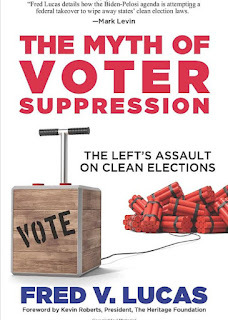
The need to secure the vote in a day of bitter political divisions is crucial. Some on the Left allege that any implementation of effective voter identification laws is actually a surreptitious attempt to suppress the vote of the poor, the under-privileged, and minorities. Such a charge deserves to be examined carefully and closely: Lucas does just that. His treatment of the subject is open handed in one respect: he exposes cheating on both the Democrat and Republican sides. It is the practice of the Left (which I must admit is generally Democrat) to oppose any attempt to secure the integrity of elections, calling such attempts “voter suppression.” Lucas coins a rather clumsy term he uses repeatedly to label these opponents: the “voter suppression hysteria industrial complex.”
The book is written in two parts. Part 1 provides a history of the ways and means of fraud in elections, as well as legislative attempts to secure the vote. Lucas’ statement in the Introduction sets the tone and direction of the book:
“A war is being fought in this country. The battlefields are Congress, in state legislative chambers, and in the courts. At stake are American democracy and the integrity of elections. The two warring narratives overlap—voter fraud vs. voter suppression—and both have historical legitimacies. But regarding the current times, only one narrative has facts to support it. The other has only emotion and inflammatory rhetoric” [xxii].Chapter 1 explores the historical linkage between fraud and suppression. As he does repeatedly, Lucas demonstrates that legislative attempts to secure the vote since the bipartisan Voting Rights Act of 1965 have generally resulted in higher, not lower, turnouts—even among minorities.
In Chapter 2, Lucas walks through the data and statistics from Arizona, Florida, Georgia, and Texas, exposing the lies that have been spun about “voter suppression” in those states. During President Biden’s January 2022 trip to Atlanta, Biden made the claim that Georgia’s efforts to put protections on the integrity of the vote were actually efforts to suppress the vote. Biden claimed, “It’s no longer about who gets to vote; it’s about making it harder to vote… It’s not hyperbole; this is a fact.” Lucas responds firmly, supplying data to back up his response to Biden’s claim: “It’s neither hyperbole nor fact. It’s demonstrably false” [31].
The author examines the data, in Chapter 3, regarding the historical voting practices of minorities to demonstrate that state-level voter ID laws have not negatively affected minority groups. Chapter 4 reveals the political forces arrayed against such common-sense efforts as purging the voter registration roles of people who have died or who have moved into a different district. Part 1 concludes with Chapter 5 detailing historical examples of the methods and attempts that have been aimed at tampering with an election.
Part 2 studies various aspects of the 2020 election. Lucas does not necessarily believe the election was stolen. On page 94 he says,
“Although the full story of the 2020 election hasn’t been told, subsequent investigations have provided noteworthy discoveries. Trump has overplayed the significance of each new discovery as absolute proof that he was the real winner—which the discoveries don’t prove.”The anomalies of the 2020 election are explored in Chapter 6. Chapter 7 details various Democratic legislative attempts at the federal level that would make election fraud easier to commit. Chapter 8 exposes President Biden’s attempts to wrest the regulation of elections from the states to the federal government (whereas Article I, Section 4, Clause 1 of the US Constitution grants that power to the states).
Lucas examines Stacy Abrams in Chapter 9, and her multitudinous claims to the effect that the 2018 Georgia gubernatorial election was stolen from her. Lucas shows that she has enjoyed a rather lucrative career making such claims. “Follow the money” is the essence of Chapter 10, as Lucas uncovers the various organizations funding the opposition to voter identification and election integrity laws. Spoiler alert: they are all on the Left.
The threads Lucas has traced in the book find their summary in the Conclusion, entitled “Stopping Tammany Hall 2.0.” He argues that legislative reform must happen at the level of individual states, and he explores several efforts that are underway.
My copy of The Myth of Voter Suppression has 453 endnotes, each providing documentation enabling the reader to go back to the original sources to substantiate the factual claims presented in the book. Lucas concludes with this thought:
“History shows there have always been demagogues resisting changes to bring more integrity to elections. It’s important the public arm itself with the facts—both historical and contemporary. This is the only way to combat the lies of the new political machine” [178].For the citizen who wants to arm himself or herself with the facts, The Myth of Voter Suppression is a good place to start. Five stars, highly recommended.
[Full disclosure: I received a free PDF copy of the book from the author for the purposes of review. I was not compensated in any way for this review.]



